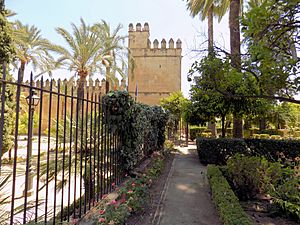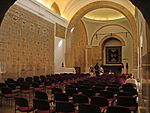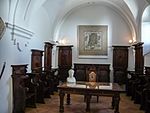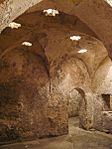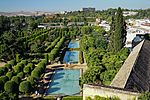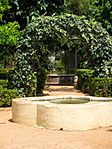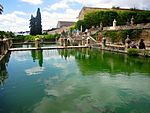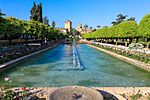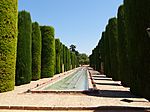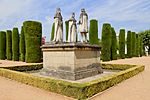Alcázar de los Reyes Cristianos facts for kids
Quick facts for kids Alcázar of the Christian Monarchs |
|
|---|---|
| Native name Spanish: Alcázar de los Reyes Cristianos |
|

The "torre del Homenaje" and the "torre de los Leones", view from the gardens
|
|
| Type | Alcázar (castle/palace) |
| Location | Cordoba, Spain |
| Built | 1328 AD (on the site of earlier structures) |
| Architectural style(s) | Spanish, Spanish Gothic |
| Type | Cultural: |
| Criteria | i, ii, iii, iv |
| Designated | 1984 |
| Part of | Historic Centre of Cordoba |
| Reference no. | 313 |
| Region | Europe |
The Alcázar de los Reyes Cristianos, also known as the Alcázar of Córdoba, is a historic castle-palace. It's located in the old part of Córdoba, in Andalusia, Spain. You can find it right by the Guadalquivir River, close to the famous Mosque-Cathedral.
This strong building was once a main home for important rulers. These included Isabella I of Castile and Ferdinand II of Aragon, known as the Catholic Monarchs. King Alfonso XI of Castile ordered its construction in 1328. He built it on top of older structures, including an Islamic-era palace.
The Alcázar looks simple and strong from the outside. But inside, it's very beautiful, with amazing gardens and courtyards. These areas show off a special style called Mudéjar, which mixes Christian and Islamic art.
The Alcázar has been recognized as a "Cultural Interest Heritage" since 1931. It's also part of the Historic Center of Córdoba. This whole area was named a World Heritage Site by UNESCO in 1994.
Contents
History of the Alcázar
The land where the Alcázar stands has a long history. In early medieval times, a Visigothic fortress was here. Later, when the Umayyads took over, their governors used this same spot.
A surviving Umayyad prince, Abd ar-Rahman I, came to Córdoba. He started the Umayyad Emirate and built a large palace complex. This became the official home and power center of Al-Andalus. The city grew into a major political and cultural hub. The palace had baths, gardens, and a huge library. Watermills on the nearby river helped water the gardens.
In 1236, Christian armies took Córdoba during the Reconquista. In 1328, King Alfonso XI of Castile began building the current Alcázar. He used parts of the old fortress. The new building kept an Islamic look because Alfonso used the Mudéjar style.
The Alcázar played a role in a civil war. Its defenses were improved with new gunpowder weapons. The main tower, now called the "Tower of the Inquisition," was built then.
Isabella and Ferdinand, later known as the Catholic Monarchs, used the Alcázar. It became a base for their fight against the last Moorish kingdom in Granada. From 1482, the Spanish Inquisition used parts of the Alcázar. They converted some areas, including old baths, into interrogation rooms. The Inquisition stayed here for three centuries.
In 1483, Boabdil, the last ruler of Granada, was held prisoner here. In 1486 or 1487, Christopher Columbus met the Catholic Monarchs here. He asked for their help to find a new sea route to Asia. They supported his journey after they conquered Granada in 1492.
In 1810, Napoleon Bonaparte's soldiers used the Alcázar as a base. In 1821, it became a prison. Finally, in the 1950s, the Spanish government made it a tourist attraction. The beautiful gardens you see today were also created around this time.
Outside the Alcázar
The Alcázar has a nearly square shape. It is surrounded by four strong towers. These towers give the building its impressive military look.
The Alcázar Towers
- Tower of Homage (La torre del Homenaje): This tower is octagonal, meaning it has eight sides. It's in the northeast corner of the Alcázar. It used to be called 'The Clock Tower' because it had a clock. Inside, you can see Gothic designs, including a pointed arch ceiling.
- Tower of the Lions (La torre de los Leones): This square-shaped tower is in the northwest corner. Visitors enter the Alcázar through a door at its base. It's the oldest tower, built in the 13th century. Its name comes from lion-shaped gargoyles at the top. Inside, there are two floors. The ground floor has the reception area. The upper floor holds the Chapel of San Eustaquio, which was the chapel for the Catholic Monarchs.
- Tower of the Inquisition (La torre de la Inquisición): This round tower is in the southwest corner. It got its name because it housed the records of the Spanish Inquisition for centuries. It was also known as the 'Tower of the Gardens'.
- Tower of the Dove (La torre de la Paloma): This square tower is in the southeast corner. The original tower was taken down in the mid-1800s. The tower you see today is a reconstruction from the mid-20th century. It was also called 'The Watch Tower'.
Inside the Alcázar
Hall of Mosaics (Salón de los Mosaicos)
This is the main hall of the Alcázar, built in the 18th century. It's called the "Hall of Mosaics" because of the amazing mosaics inside. These mosaics were found in the 1950s at Corredera Square. They were once part of a Roman Circus. You can also see a sarcophagus (a stone coffin) from the 3rd century here. Today, many people in Cordoba choose this hall for their civil marriage ceremonies.
Underneath the hall's floor, you can still find parts of what are believed to be Royal Baths. These baths were used by important people during the Muslim era.
Courtyard of the Moriscos (Patio Morisco)
This courtyard is also known as the Mudejar Courtyard. It's on the western side of the Alcázar. It has a square shape and is surrounded by arched walkways. The western side connects the Tower of the Lions and the Tower of the Inquisition. This is also where you can enter the beautiful Gardens of the Alcázar. In the center of the courtyard, there's a water fountain between two small ponds.
Courtyard of the Women (Patio de las mujeres)
This courtyard is on the eastern side of the Alcázar. It got its name from a time when the Alcázar was a prison. This courtyard was where the women's section of the prison was located. Here, you can see many old remains from different building periods of the Alcázar. These include parts of former buildings, a Roman fort, and the Andalusian Alcázar.
Royal Baths of Doña Leonor (Baños reales de Doña Leonor)
King Alfonso XI built these Royal Baths in 1328. They were designed with four different rooms. These included a changing room, a cold room, a temperate room, and a hot room. The baths are named after Leonor de Guzmán. She was the King's mistress, and the baths were built in her honor.
Gardens of the Alcázar (Jardines del Alcázar)
Gardens and orchards have been in this area for a very long time. As early as the 10th century, an aqueduct brought water here. This water came from the nearby Albolafia waterwheel. Over time, the gardens were sometimes neglected and sometimes renewed. In the late 1400s or early 1500s, Queen Isabella I stopped the waterwheel. This caused the gardens to decline.
The beautiful gardens you see today were mostly created in the mid-20th century. At that time, some garden space was lost due to a new road.
Today, the gardens cover about 55,000 square meters. They are filled with trees like palm, cypress, orange, and lemon trees. Many elegant fountains and ponds are also part of the design. The gardens are divided into three levels: the Higher Garden, the Middle Garden, and the Lower Garden.
The Higher Garden is between the Tower of the Lions and the Royal Stables. The Middle Garden is next to the castle wall. It has two large pools and can be reached by a grand staircase. The Lower Garden is the largest area. It features three long pools with flowers and trees. It also has other carefully designed garden sections.
The Lower Garden also includes the King's Avenue, or Promenade of Kings. This path is lined with cypress trees and has two narrow ponds. Along this walk, you'll find sculptures of kings who helped build the Alcázar. One sculpture shows Christopher Columbus with Queen Isabella and King Ferdinand. This remembers Columbus's first meeting with the Catholic Monarchs, which happened right here at the Alcázar.
-
Statues of the Catholic Monarchs and Christopher Columbus at the Promenade of Kings
See also
 In Spanish: Alcázar de los Reyes Cristianos para niños
In Spanish: Alcázar de los Reyes Cristianos para niños


